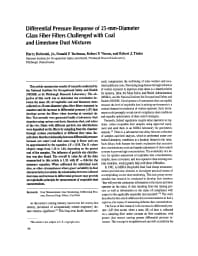Mining Publication: Differential Pressure Response of 25-mm-Diameter Glass Fiber Filters Challenged with Coal and Limestone Dust Mixtures
Original creation date: February 2002
Authors: HH Dobroski, DP Tuchman, RP Vinson, RJ Timko
NIOSHTIC2 Number: 20022689
Appl Occup Env Hyg 2002 Feb 17(2); :96-103
This article summarizes results of research conducted by the National Institute for Occupational Safety and Health (NIOSH) at its Pittsburgh Research Laboratory. The objective of this work was to determine the correlation between the mass (M) of respirable coal and limestone dusts collected on 25-mm-diameter glass fiber filters mounted in cassettes and the increase in differential pressure (deltaP) that develops across the filters when drawing at constant air flow. Test aerosols were generated inside a laboratory dust chamber using various coal dusts, limestone dust, and mixes of the two. Dusts with different particle size distributions were deposited on the filters by sampling from the chamber through cyclone preclassifiers at different flow rates. Results show that the relationship between differential pressure increase (cm water) and dust mass (mg) is linear and can be approximated by the equation deltaP = KM. The K values (slopes) range from 1.14 to 1.64, depending on the parent coal of the samples. The influence of particle size distribution was also found. The overall K value for all the data summarized in this article is 1.35, with R2 = 0.84 for the summary equation. When calibrated for individual work sites, or other circumstances where great variability in dust characteristics is avoided, the relationship between collected dust mass and increase in differential pressure may provide an exploitable principle for measurement of respirable dust concentrations.

NIOSHTIC2 Number: 20022689
Appl Occup Env Hyg 2002 Feb 17(2); :96-103
- Coal Dust Explosibility Meter Evaluation and Recommendations for Application
- Determining Flame Travel Measurements from Experimental Coal Dust Explosions
- Effectiveness of Dust Dispersion in the 20-L Siwek Chamber
- Evaluation of LIDAR as a Novel Remote Dust Sensing Technology
- Full-Scale Testing of the Float Dust Deposition Meter
- How Does Limestone Rock Dust Prevent Coal Dust Explosions in Coal Mines?
- Rock Dusting
- Rock Dusting Considerations in Underground Coal Mines
- Status of a Tapered Element, Oscillation Microbalance-Based Continuous Respirable Coal Mine Dust Monitor
- Test Report on the Machine-Mounted Continuous Respirable Dust Monitor